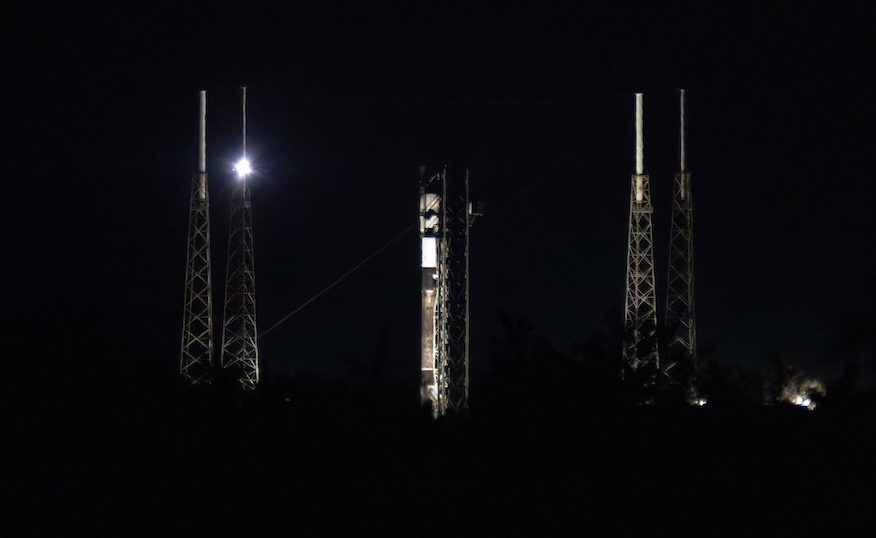
Falcon 9 rocket moments before launching Starlink Group 10-34 with next-gen V2 Mini satellites. (Image Credit: Spaceflight Now)
The Starlink 10-34 mission launched a new batch of Starlink V2 Mini satellites with advanced laser communication and phased array antennas, aiming to revolutionize internet connectivity across the globe. In this detailed article, explore what makes these satellites different from earlier versions, how they enhance low Earth orbit internet performance, and why the Starlink V2 Mini is a key component of SpaceX’s Gen2 network expansion.
Introduction
SpaceX is revolutionizing the way we access the internet, especially in remote and underserved regions. With every new batch of Starlink satellites, their capabilities improve drastically. The recent launch, Starlink Group 10-34, wasn’t just another mission—it marked a major leap forward using the latest Starlink V2 Mini satellites. But what exactly are these V2 Minis? And why is Starlink 10-34 so important?
In this blog, we’ll dive deep into this advanced satellite generation, their role in reshaping connectivity, and what new technologies they bring onboard—all in a simple, human way with updated data and visuals.
1: Starlink Satellite Evolution
| Version | Size & Weight | Features | Launch Period |
|---|---|---|---|
| Starlink V1 | ~260 kg | Basic internet coverage | 2019–2021 |
| Starlink V1.5 | ~295 kg | Laser interlinks (limited) | 2021–2023 |
| Starlink V2 Mini | ~800 kg | Laser links, phased antennas | 2023–present |
| Starlink V2 (Full) | ~1,250 kg | Gen2 hardware, max performance | Testing in 2025 |
What Are Starlink V2 Mini Satellites?
Starlink V2 Mini satellites are part of the second-generation satellite network that SpaceX is building under its Starlink Gen2 license. These are “mini” only in comparison to the upcoming full-sized Starlink V2 satellites, but they carry massive improvements over Starlink V1 and V1.5.
Key Upgrades in V2 Mini:
- Inter-satellite laser links: Data transfers directly between satellites in space, reducing reliance on ground stations.
- Phased array antennas: Wider beam coverage and improved download/upload speeds.
- Larger solar arrays & power efficiency: Supports higher bandwidth operations with better longevity.
- AI-based traffic routing: Some V2 Minis are reportedly capable of auto-optimizing bandwidth routing.
These satellites are designed to boost global internet speeds, reduce latency, and enhance real-time communications worldwide.
For more satellite comparisons and updates, visit our Starlinhttps://veenaspace.reviewk Mission page.
What Was New in Starlink Group 10-34?
The Starlink Group 10-34 mission launched on 28 June 2025 from Cape Canaveral Space Force Station using a Falcon 9 rocket. It successfully deployed around 27 Starlink V2 Mini satellites into Low Earth Orbit (LEO) at approximately 530 km altitude.
What made this launch special?
- ✅ 53.2° Inclination: Offers stronger internet coverage across North America, Europe, and parts of Asia.
- ✅ Boosted Network Capacity: These V2 Mini satellites handle more traffic, vital for high-demand areas.
- ✅ Laser-Linked Mesh: These satellites sync via laser to pass signals instantly across continents.
- ✅ Booster Reuse: The Falcon 9 used for this mission had flown 15+ times, showcasing sustainability.
This mission follows previous successes like Starlink 10-33 and continues to build a stronger LEO satellite network.
2: Starlink V2 Mini vs V1 Comparison
| Feature | Starlink V1 | Starlink V2 Mini |
|---|---|---|
| Mass per Satellite | ~260 kg | ~800 kg |
| Laser Communication | No | Yes |
| Max Bandwidth per Unit | ~20 Gbps | ~80 Gbps |
| Antenna Type | Narrow Beam | Wide Beam + Phased Array |
| Power Supply | Basic | Advanced Solar Arrays |
| AI Optimization | No | Limited AI Traffic Management |
Why Do Starlink V2 Mini Satellites Matter?
If you’re wondering why all this tech upgrade matters to a regular internet user, here’s the real-world impact:
- 📶 Better Internet in Remote Areas: No fiber? No problem. Starlink V2 Mini beams connectivity anywhere.
- ⏱️ Lower Latency: Ideal for online gaming, video calls, and real-time communication.
- 🌍 More Global Reach: With LEO deployment and laser mesh, these satellites reduce dead zones.
- 🛰️ Military & Emergency Use: Helps connect critical missions and disaster zones instantly.
To explore more about Starlink’s global impact, check SpaceX’s official Starlink page.
📊 Graph 3: Starlink Launch Timeline (Simplified)
| Year | Launches (Approx.) | Major Upgrade Stage |
|---|---|---|
| 2019 | 6 | First Gen (Starlink V1) Begins |
| 2021 | 15 | V1.5 Satellites Introduced |
| 2023 | 30+ | V2 Mini Deployment Starts |
| 2025 | 40+ (est.) | Full Gen2 Constellation in Progress |
Conclusion
Starlink V2 Mini satellites are not just a technical upgrade—they represent a bold step toward democratizing high-speed internet. The Starlink 10-34 mission proved how far this technology has come and how SpaceX is actively pushing the boundaries of satellite communication.
With better bandwidth, smarter routing, and unmatched coverage, V2 Minis are rewriting the future of how we connect—on land, at sea, and in the sky. Keep watching the skies; your internet might just be flying overhead.
🚀 Call to Action
If you found this article insightful, don’t forget to:
✅ Bookmark this blog for more upcoming Starlink mission breakdowns.
✅ Share it with fellow space and tech lovers.
✅ Visit VeenaSpace.com regularly for deep insights into SpaceX, Starlink, and the future of internet connectivity.
Want us to cover another Starlink launch in detail? Drop your request in the comments or message us on our contact page. Let’s decode space together!
